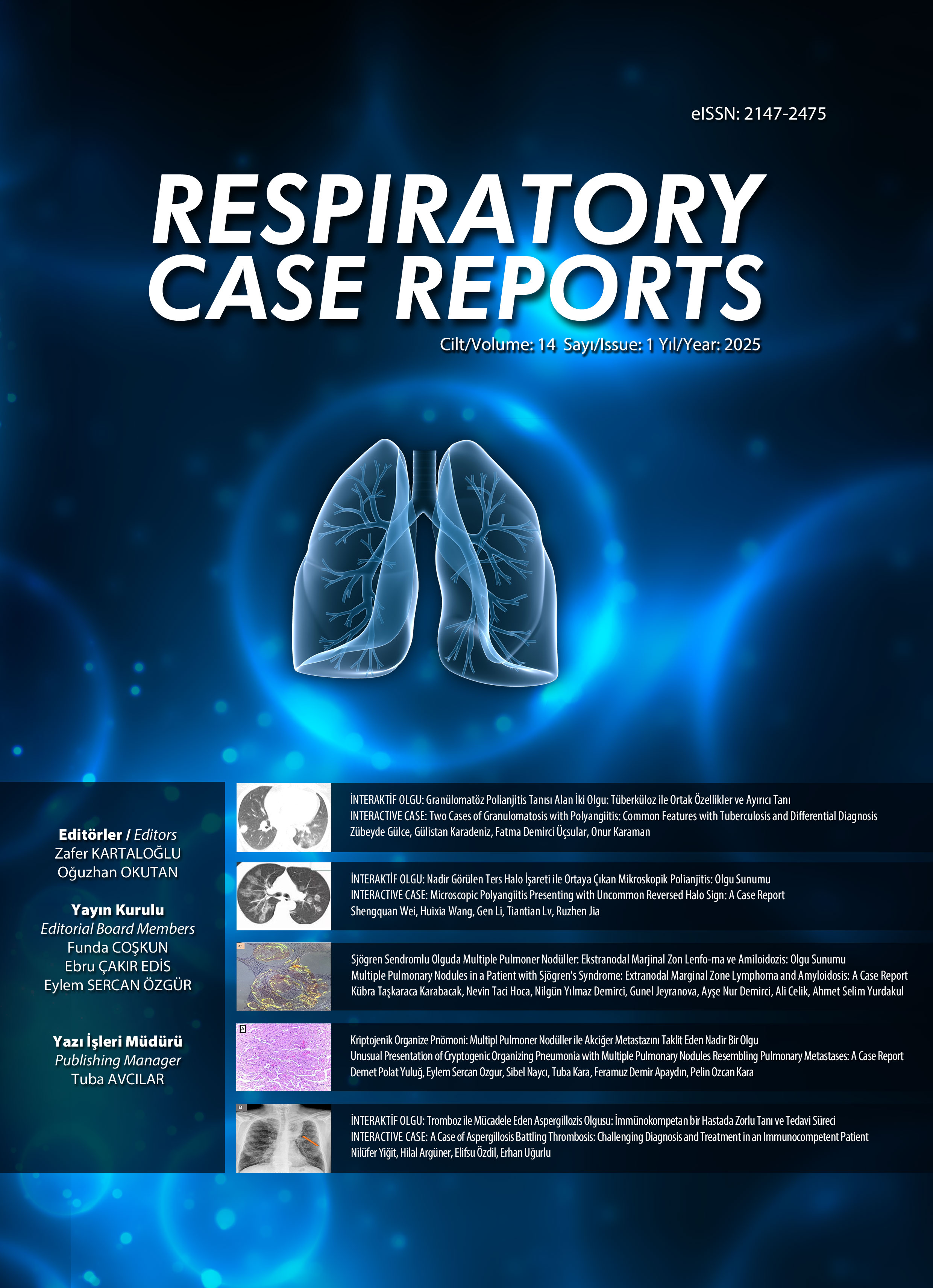e-ISSN 2147-2475

Volume: 10 Issue: 1 - February 2021
| CASE REPORT | |
| 1. | Vertical Transmission of COVID-19 in Children of Sero-positive Mothers to SARS-CoV-2 in Southeast Mexico: A Case Report Diego Lopez Salinas, Fabiola Barba Leon, Liliana Rodríguez García, Maria Valeria Jimenez-Baez, Federico Garma Montiel, Maria Eugenia Sanchez Castuera doi: 10.5505/respircase.2021.05826 Pages 1 - 7 The clinical features of Covid-19 have been described in adults and infants younger than 1 year of age, although there is little data on the characteristics and the potential of intrauterine transmission in newborns. A case of infection was identified in a baby born in Cancún Quintana Roo, in a regional hospital at the beginning of the epidemic. The patient did not require intensive care, nor were there any serious complications. The mother was infected with SARS-CoV-2, showing mild respiratory symptoms. Although 10 mothers with symptoms of SARS-CoV-2 have been observed to date, only one case of a positive newborn has been identified in the hospital. In summary, newborns are susceptible to SARS-CoV-2 infection. The SARS-CoV-2 PCR-positive newborn had no symptoms, and so SARS-Cov2 may be considered less severe in neonates than in adults. Vertical intrauterine transmission in women who develop COVID-19 pneumonia is possible, although evidence is still lacking in Latin America and around the world. |
| 2. | Spontaneous Pneumothorax in Severe COVID-19 Pneumonia: Interventional Treatment and Risk of Transmission Mia Elhidsi, Prasenohadi Prasenohadi, Dicky Soehardiman doi: 10.5505/respircase.2021.58224 Pages 8 - 11 Severe Acute Respiratory Syndrome Coronavirus 2 (SARS-CoV2), or Coronavirus disease 2019 (COVID-19), is a highly contagious and rapidly-spreading disease. While pneumonia is a common finding, pleural space involvement, such as pneumothorax, occurs only in rare cases. Pneumothorax requires the immediate insertion of a chest tube. Thoracostomy procedures require prompt and precise management, but with caution to avoid the risk of transmission. We report here on a 49-year-old male patient who was admitted to the emergency ward with shortness of breath and oxygen desaturation. A physical examination and portable chest X-ray indicated a left pneumothorax. The patient underwent tracheal intubation followed by chest tube insertion, and the lungs inflated two hours after the procedure. The operators included two people, wearing personal protective equipment (PPE), including N95 masks, full eye protection, a face shield and a fluid-resistant gown. Two weeks following chest tube insertion, the operators underwent a SARS-CoV2 PCR examination, with negative results. This report discusses relevant findings in literature related to the current issue. |
| 3. | Bleomycin-Induced Fatal Lung Toxicity Misdiagnosed as Covid-19 Pneumonia: A Case Report Murathan Köksal, Yasin Celal Güneş doi: 10.5505/respircase.2021.78055 Pages 12 - 15 Bleomycin is a chemotherapeutic agent that is preferred for the treatment of testicular cancer, lymphoma and some squamous cell carcinomas. Bleomycin-induced lung toxicity is a common, but rarely fatal side-effect, and the radiological image of which can be confused with other reasons which makes organizing pneumonia pattern. We report here on the case of a 40-year-old male patient with testicular cancer with bleomycin-induced fatal lung toxicity that was misdiagnosed as Covid-19 pneumonia. The patient suffered subsequent fatal spontaneous pneumomediastinum, pneumothorax, and pulmonary interstitial and subcutaneous emphysema, and died from respiratory failure. |
| 4. | A Case of Chronic Eosinophilic Pneumonia Confused with Covid-19 Pneumonia Selvi Aşker, Hanifi Yıldız, Nevzat Esen, Müntecep Aşker doi: 10.5505/respircase.2021.03764 Pages 16 - 22 The etiology of chronic eosinophilic pneumonia (CEP) is not precisely known, although its characteristic features include eosinophilia, involving alveoli or blood; subacute or chronic respiratory and general symptoms; while chest radiological imaging shows peripheral pulmonary infiltrates. Many cases of pneumonia associated with the new coronavirus (2019-nCoV) were detected in Wuhan, China starting in December 2019. HRCT is a highly sensitive and convenient screening tool for 2019-nCoV. The radiological appearance of the new coronavirus pneumonia is not very different from that of the common viral pneumonia, but it has some unique features. It usually manifests with patchy or punctuate opacities resembling ground glass (85.7%), and patchy consolidation (19.0%), and the lesions are mainly located in the subpleural area. Here we present a case of CEP who presented with shortness of breath, cough, fever, and a clinical and radiological picture similar to COVID-19. |
| 5. | A Rare Case of Pulmonary Infection: Endobronchial Actinomycosis Serhat Özgün, Büşra Yaprak Bayrak, Tuba Çiftçi Küsbeci, Ahmet Ilgazlı doi: 10.5505/respircase.2021.59354 Pages 23 - 26 Pulmonary actinomycosis is a bacterial disease that can be difficult to diagnose due to its nonspecific clinical and radiological findings caused by actinomyces. A 59-year-old female patient presented with a history of coughing and white sputum for the last one year. Here, we present a rare case of endobronchial actinomycosis with an endobronchial lesion obstructing the basal segments of the right lower lobe, diagnosed from a transbronchial biopsy taken during a fiberoptic bronchoscopy. |
| 6. | A Case of Severe H1N1 Pneumonia Complicated with Spontaneous Pneumomediastinum and Pneumothorax Fatoş Kozanlı, Özlem Güler doi: 10.5505/respircase.2021.71677 Pages 27 - 30 Cases of spontaneous pneumomediastinum and spontaneous pneumothorax related with influenza A (H1N1) infection in adults are quite rare. The case presented here was a 33-year old female patient admitted to the emergency room with high fever, severe dyspnea, cough and altered consciousness. Pneumomediastinum and bilateral pneumothorax were detected on a chest roentgenogram and thoracic computerized tomography imaging. The H1N1 virus was identified in a nasal smear and in tracheal aspirate samples. Clinicians should be aware of this rare complication of the Influenza A virus that has started to be seen in literature. |
| 7. | Aripiprazole-Induced Pulmonary Toxicity in a Patient with Obsessive-Compulsive Disorder Fatma Selen Ala, Mustafa Emre Duygulu, Nurhan Köksal, Tibel Tuna doi: 10.5505/respircase.2021.10437 Pages 31 - 35 A 33-year-old male patient with a diagnosis of obsessive-compulsive disorder applied to the emergency department with fever, cough, sputum and increasing shortness of breath. A physical examination revealed the patient to be dyspneic and orthopneic. Bilateral rales were present in middle and basal lung areas. Oxygen saturation in room air was 84%. Diffuse parenchymal infiltration and consolidation areas were noted in a posteroanterior chest X-ray and a thorax computerized tomography. The patients history revealed that the patient used a CPAP machine due to obstructive sleep apnea syndrome and aripiprazole, related to his obsessive-compulsive disorder. The patient was hospitalized in the intensive care unit with a preliminary diagnosis of pneumonia and treated with ceftriaxone 2 gr/day, clarithromycin 2x500 mg and oseltamivir 2x75 mg. Blood and sputum cultures, viral markers and procalcitonin were negative, and so methylprednisolone 40mg/day was started. The patients clinical condition improved rapidly after treatment with steroids, and he was discharged on the 8th day after admission, with recommendations for ambulatory care. It was learnt that aripiprazole had been added to his treatment for obsessive-compulsive disorder 1 month earlier, and that his complaints had started and gradually intensified 20 days after this change in medication. The patients clinical picture was assessed as lung toxicity caused by aripiprazole. |
| 8. | Thrombocytopenia as First Manifestation of Acute Massive Pulmonary Embolism Nai-Chien Huan, Kang Yang Ng, Khai Lip Ng, Jamalul Azizi Abdul Rahaman doi: 10.5505/respircase.2021.36449 Pages 36 - 40 Massive acute pulmonary embolism (PE) is a life-threatening medical condition. Occasionally, patients experiencing a massive PE may develop concurrent thrombocytopenia. A 64-year-old female was admitted for left femur osteomyelitis with a sub-periosteal abscess that was causing pain and immobility. There were no indications suggesting underlying thrombophilia or malignancy. On day 5 of admission, the patient developed acute onset respiratory distress, necessitating intubation and vasopressor support. A computed tomography pulmonary angiogram revealed a massive PE involving the left main trunk and left ascending pulmonary artery. The patient had experienced an unexplained worsening thrombocytopenia that despite without heparin use previously. There was clear indication for thrombolysis, but the treatment was contraindicated. After a multidisciplinary meeting it was decided to optimize platelet counts prior to the performance of a surgical embolectomy, however the patient succumbed 2 days later. The unexplained thrombocytopenia could be the only clue for massive PE. Clinicians should remain vigilant to ensure early diagnosis and improved outcomes. |
| 9. | Evaluation of fitness for work in a Case with COPD Merve Atik, Ayse Coskun Beyan, Arif Hikmet Çımrın doi: 10.5505/respircase.2021.05668 Pages 41 - 46 Today, approximately 25% of the working populations have at least one chronic disease, and so the delineation fitness for work is quite important. The process for the evaluation of fitness for work is evaluated in this paper, alongside a detailed work analysis and a further functional evaluation of an employee who presented to our work and occupational illnesses clinic with a diagnosis of chronic obstructive pulmonary disease (COPD). A 39-year-old male with the diagnosis of COPD, who was employed at a rim factory, was subjected to a cardiopulmonary exercise test, and a work analysis revealed that the energy requirement of the work was above the acceptable limits for the case. The smoke, dust and metal identified in the environment were thought to contribute to the exacerbation and progression of COPD. Modifications to the patients work to suit his cardiopulmonary capacity, and reducing the defined risks was suggested. Evaluating work compatibility is an important area of study requiring the collaboration of many disciplines, and occupational disease specialists in particular, with the am being to protect the health of the workforce and the continuity of works. |
| 10. | Hybrid Congenital Lung Malformation with Difficulty in Diagnosis and Treatment: Congenital Cystic Adenoid Malformation and Pulmonary Sequestration Co-existence Bengisu Arabacı, Kenan Can Ceylan, Nur Yücel, Seyda Ors Kaya doi: 10.5505/respircase.2021.20092 Pages 47 - 50 Congenital abnormalities of the lung can manifest in any component of the bronchopulmonary system. Congenital lobar emphysema, bronchogenic cyst, congenital cystic adenoid malformation (CCAM) or pulmonary sequestration (PS) are just some of the many kinds of malformations of the lung. The co-existence of CCAM and PS is a very rare condition. Due to such complications as dyspnea or recurrent infection, most malformations are diagnosed antenatally or in the immediate postnatal period. The present case was not diagnosed until late adolescence, and the patient was subsequently referred to our clinic after undergoing a previous operation. After examinations and a preoperative evaluation, a second operation was performed. We present to literature a very rare case of co-existing CCAM and PS (hybrid lung malformation). |
| 11. | Langerhans Cell Histiocytosis in the Chest Wall Muharrem Çakmak, Adile Ferda Dağlı doi: 10.5505/respircase.2021.30164 Pages 51 - 54 Langerhans Cell Histiocytosis (LCH) refers to a non-neoplastic proliferation of Langerhans cells with an incidence in the adult population of 12 per million. It is considered a pediatric disease, and while rib involvement is very rare, we report here on a 33-year-old patient with LCH located in the rib. |
| 12. | A Rare Cause of Pneumomediastinum: Foreign Body Aspiration Tolga Semerkant, Hıdır Esme, Celebi Kocaoglu doi: 10.5505/respircase.2021.53325 Pages 55 - 58 Pneumomediastinum is characterized by the presence of air in the mediastinum. Non-traumatic pneumomediastinum is rarely seen in children, and while the most common cause is asthma, foreign body aspiration should be considered in children younger than 3 years of age. The determinant of the clinical picture in these cases is the severity of dyspnea. Fasciotomy should be performed prior to rigid bronchoscopy, and mediastinal compression should be decreased in the presence of a marked dyspnea. Here, we present the case of a 2-year-old patient with pneumomediastinum secondary to foreign body aspiration, and discuss the alternative approaches to such cases in the light of literature findings. |
| 13. | Malignant Peripheral Nerve Sheath Tumor Related to Diffuse Neurofibroma of Chest Wall Muharrem Çakmak, İsmail Demirel doi: 10.5505/respircase.2021.04696 Pages 59 - 62 Malignant peripheral nerve sheath tumors account for 510% of all soft tissue tumors. These tumors are closely related with Neurofibromatosis type 1. Although many such tumors have been reported in different locations, malignant peripheral nerve sheath tumors arising from diffuse neurofibroma located in the chest wall are extremely rare. In the present study we report on a malignant peripheral nerve sheath tumor arising out of a diffuse neurofibroma of the chest wall. |
| 14. | Thoracic Splenosis Hüseyin Fatih Sezer, Tuba Çiftçi Küsbeci, Ahmet Hamdi Ilgazlı doi: 10.5505/respircase.2021.43043 Pages 63 - 66 The spread of spleen tissue through different parts of the body is referred to as autotransplantation splenosis, and is an acquired and rare condition. The focal spread of splenic tissue into the thorax due to diaphragm laceration is referred to as thoracic splenosis, and may present as more than one pleural nodule in the left hemithorax. It usually occurs after a blunt trauma causing a combination of spleen injury and left diaphragmatic rupture. In the present study, we present a case of intrathoracic splenosis in an 18-year-old male patient who had undergone a splenectomy 14 years earlier after suffering a gunshot wound. |











